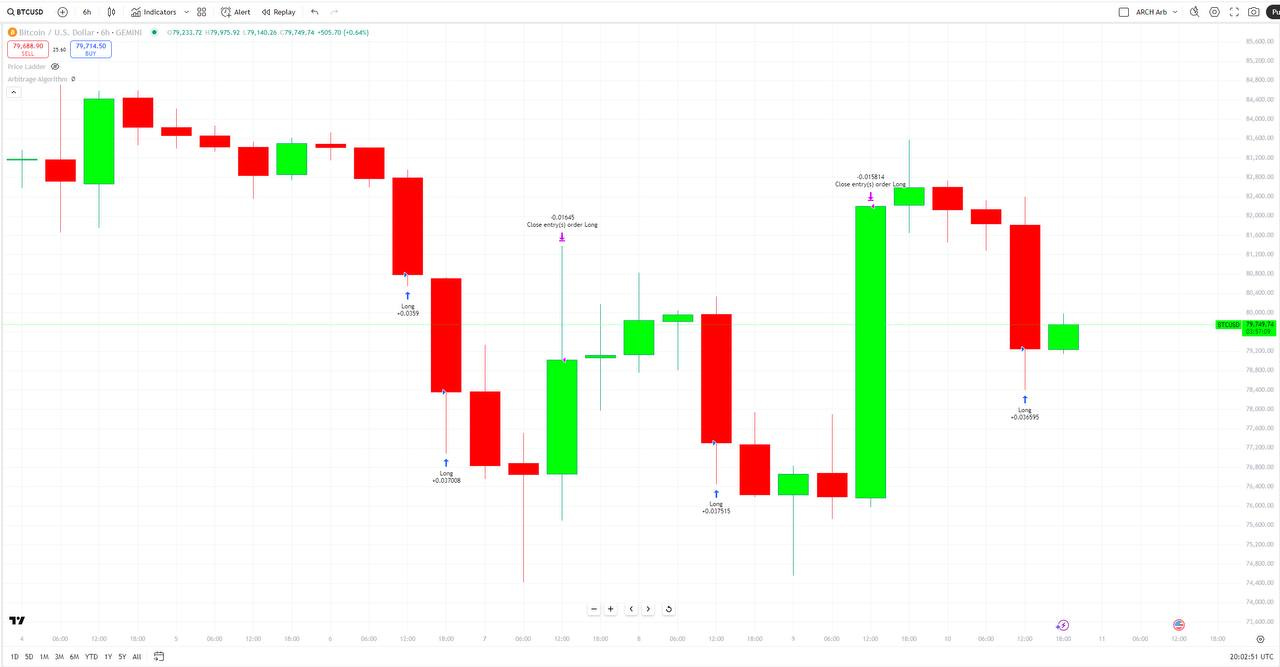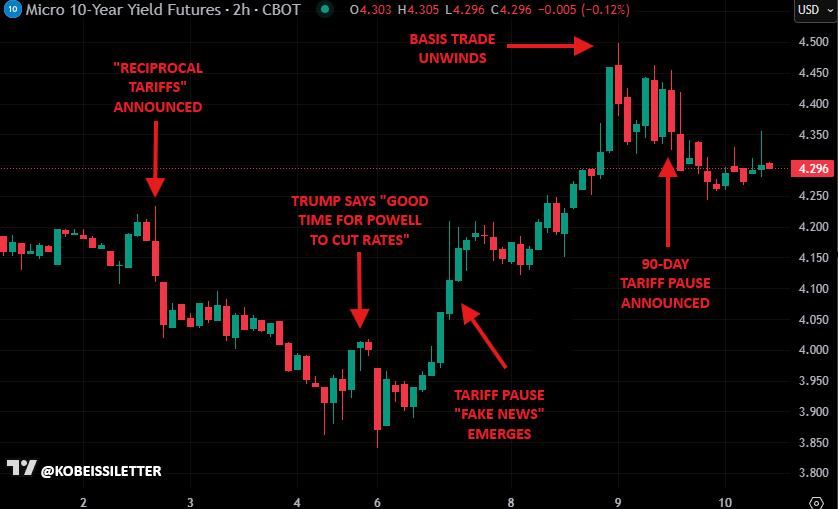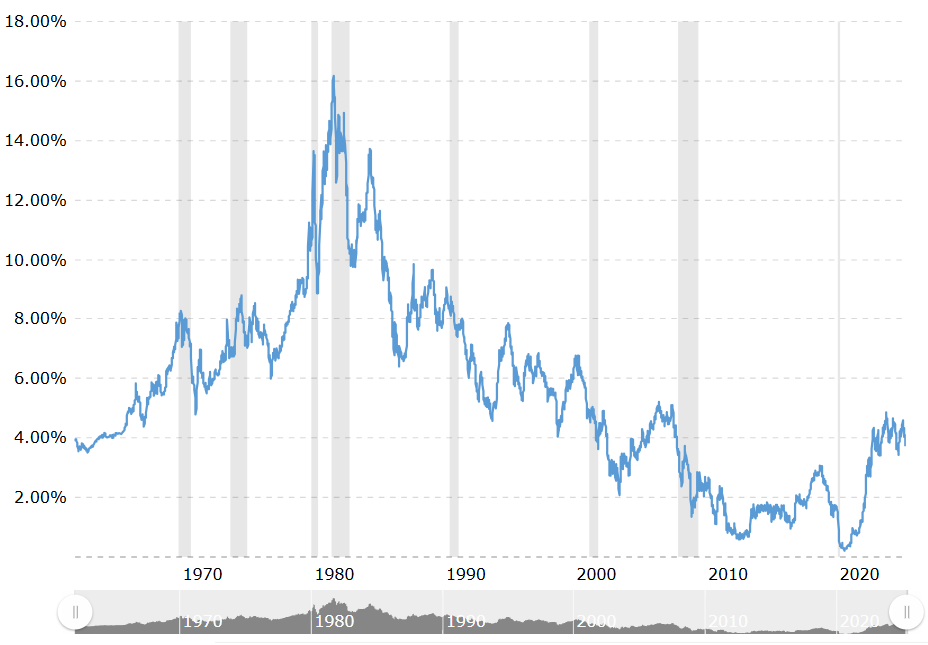Welcome to The Wolf Den! This is where I share the news, my ideas about the market, technical analysis, education and my random musings. The newsletter is released every weekday and is completely FREE. Subscribe!
Today’s Newsletter Is Made Possible By Arch Public!
The Bitcoin Algorithm Arbitrage Strategy has crushed it over the past 60 days!
+21% total return.
+9% cash yield.
Last two weeks have seen extraordinary results; exits on green candles, entries on red candles. Institutional tool = FREE!
If you aren’t using our hands-free tool you’re playing the game with on hand tied behind your back. Front run corporates and nation states and stack more sats!
In This Issue:
Bonds Gone Wild
Aptos Weekly Review
Bitcoin Thoughts And Analysis
Trade War Escalates, Markets Become Unhinged
Block Settles With NYDFS
Virgil Griffith Has Been Released From Prison
There Are Now Three DOGE ETF Filings
Bitcoin To Hit $250,000 This Year, Even With Tariff Insanity
Bonds Gone Wild
I spoke too soon.
I’m taking back yesterday’s booooom. As I’ve said many times, the most profitable days tend to show up in volatile, unhealthy markets – and we just got a real-time reminder.
If it wasn’t weird enough watching the S&P 500 rip 10% in a single day only to give back nearly half of it the very next, the bond market is piling on with its own chaos. Yields are swinging like crazy as investors scramble to price in rate cuts, inflation pressures, and conflicting economic signals.
Even the president chimed in: “The bond market is very tricky, I was watching it. The bond market right now is beautiful. But yeah, I saw last night where people were getting a little queasy.”
Markets don’t get more confused than this - and we he never seen them this tied to the comments of a single man.
Here’s a picture of the bond chaos, courtesy of The Kobeissi Letter annotating the chart:
Before the April 2 “reciprocal tariffs,” the 10-year Treasury yield had been steadily declining from 4.8% in mid-January – a signal that the trade war might drag on without causing too much disruption. But after last week’s surge in volatility and the unwinding of the basis trade (a popular hedge fund arbitrage strategy in bonds), yields spiked sharply – jumping 65 basis points to 4.50%.
Just to add some quick context before getting to the main point – it's now common to hear people say the bond market is “breaking” due to these wild swings. What does that actually mean? Since the 10-year yield acts as a benchmark for everything from mortgages to corporate debt, instability in yields signals deeper stress in the financial system. When the safest, most liquid market starts behaving erratically, it points to something seriously wrong beneath the surface.
Think about it this way: if you drive over a bridge every day and it usually sways gently in the wind, but one week it starts swinging violently – strong wind, sudden temperature changes, heavy rain, more traffic – you’d naturally start to question its stability. Even if it collapsed when no one was on it, it would still be a disaster. You wouldn’t get to work, and your work would suffer. The same goes for the bond market – whether yields spike or collapse, extreme movement is a red flag.
Since March 2020 – the last time it felt like the markets were unraveling – the 10-year yield has marched steadily higher. At the peak of COVID panic, the 10-year was at just 0.34%. Let that sink in: buying a 10-year Treasury then would’ve earned you 0.34% annually for a decade. Those who fled to bonds for “safety” got wrecked. They missed one of the most explosive risk-asset rallies in history and locked in nearly zero returns for the privilege.
Here’s a chart of the bond market over the past five years. Look closely at the far right – the size of those candles is gnarly.
Let’s zoom out a little further and switch gears over to the 5-Year.
5-Year Treasury Rate - 54 Year Historical Chart
And now the 10-Year.
10-Year Treasury Rate - 54 Year Historical Chart
When you zoom out far enough, our five-year “march” in yields looks more like a “leap.” Trump is pushing back against this trend because he knows lower yields would benefit the broader economy – reducing borrowing costs, spurring investment, and boosting consumer spending. In short: lower yields = good for markets. It’s wild how differently bonds are viewed today compared to 40 years ago, which brings me to today’s main point – the bigger picture when it comes to bonds.
Not that long ago, bonds held a reputation as the cornerstone of a stable retirement – a pathway to generational wealth. Ask your parents about bonds and how hardworking people used to invest $100,000, reinvest the dividends, and watch it grow into $500,000 or more over 30 years. Believe it or not, there was a time when the American Dream felt straightforward. That world doesn’t exist anymore.
But the bond market is back – and with it comes a whole new set of decisions. Yields in the mid-4% range may seem tame compared to the 9% or 15% yields of the 1980s, but in today’s landscape, 4.376% is looking more and more attractive. Imagine what 9% would look like today – the kind of profits that could generate for a portfolio are almost unimaginable in our current market.
Spoiler alert: Trump doesn’t want that.
Now let’s take a step back and look at who actually buys bonds in the first place. These are the groups that traditionally lean into fixed income:
– Individual investors: People looking for a steady income stream and low volatility. They usually invest through mutual funds or directly in Treasuries.
– Institutional investors: Pension funds, insurance companies, and other big players deploying large sums on behalf of their clients.
– Government entities: Central banks and treasuries often buy bonds to manage reserves or monetary policy.
– Corporations: Businesses sometimes park excess cash in bonds to earn a safe return.
A few years ago, bonds were practically considered dead weight (chart below will make that clear). But now? Investors are interested again. Especially with Trump likely to push for lower yields, the window for solid bond returns could start closing.
To be clear: I still think Bitcoin is a far better long-term hold. The bond market’s volatility lately is off the charts.
Here’s a look at yields from 2020, before COVID flipped the table.
In 2020 and 2021, earning any meaningful interest required investing at least a few million dollars. Yields were so anemic that most everyday bond buyers didn’t even bother, and analysts widely labeled the market as “broken.” Over the past decade, trying to replicate the returns our parents or grandparents enjoyed would’ve required the entire household grinding nonstop just to scrape together leftovers to invest.
For a while, the bond landscape felt like running on a treadmill that kept speeding up and stretching out - until hitting the emergency stop became nearly impossible. Eventually, most families got flung off the back, left with little hope of saving enough for retirement. But now, that treadmill has finally slowed down, and for the first time in a long while, investors have a real reason to step back on.
Just take a look at these yields from 1990.
Bond markets should move over decades - not overnight. Yet here we are. Trump is definitely watching this closely, and you can bet he’s shaping his decisions around what’s happening in fixed income. He just asked the Supreme Court to let him fire top officials at federal agencies - and let’s be real, Powell’s probably on that mental list.
One last thing worth noting: all the recent bond market chaos has spooked investors into gold - and that play has worked. If history is any guide, Bitcoin is probably next.
Hopefully, this intro offered a bit of perspective — a historical lens on bonds, a nod to their erratic nature lately, and some thoughts on the opportunities that might exist in today’s bizarre landscape (just a reminder to get advice from a licensed financial advisor, not me). Personally, I think rates will drop substantially in the coming years, and when they do, crypto will rise in their absence. Bitcoin will become the risk-haven of choice for investors who want something more than a 2–3% yield. And Ethereum staking, in particular, could benefit massively.
Of course, this is all just speculation - I could be totally wrong. So as always, do your own research. The smoke will settle eventually. Even if we take another leg lower in legacy and crypto, just hang tight.
Just keep stacking or holding - that’s all you need to do.
Aptos Weekly Review
For those that don’t know, Aptos - one of the most exciting layer 1 blockchain competing with Solana and Ethereum—is now an official sponsor of this newsletter! Over the past few months, I’ve had the chance to get to know the Aptos team, create content with them, and watch this project accomplish incredible things.
Each week, I’ll provide an Aptos review, covering the network’s latest announcements and achievements. This week, I want to focus on this article by Avery Ching, Aptos Labs CEO, “Building the Global Trading Engine.” It came out just after I did last week’s weekly review, but it was too good not to pass up.
The highlights are below:
This sounds a lot like tokenization… I love to hear it.
Boom, confirmed. Aptos gets it. The world is moving on-chain and Aptos will play a role in that process.
“Aptos is one of the few blockchains to support the top 3 major stablecoins by market cap (USDT, USDC, and USDe), reaching a $1B+ market cap in a few months. In fact, on a percentage basis, USDT on Aptos has grown faster than any other chain since the beginning of 2025.”
“The Aptos Foundation has committed $200M in new grants and investments focused on ecosystem growth, supporting innovative and world-class builders building on the global trading engine.”
“In 2024, Aptos showed its technical chops as the best place for developers to build the world’s global trading hub. The blockchain sustained heavy loads of over 11,000 TPS+, maintaining instant finality at a fraction of a cent in gas costs. In lab settings, the network’s parallel execution engine (Block-STM) demonstrated the ability to handle loads of up to 160,000 TPS and with Shardines showcasing over 1,000,000 TPS.”
“The world’s $190 trillion cross-border payments and $200+ trillion traditional financial markets are ripe for disruption. The crypto-native financial stack is emerging, but it needs infrastructure that’s purpose-built for scale and stability. Aptos is here to lead. Our vision is ambitious but focused — continuously pushing the boundaries of what’s possible with blockchain-based technology while maintaining a steadfast commitment to user experience and real-world utility.”
That is all for this week, make sure to show Aptos some love - they’re a huge reason this newsletter remains free!
Bitcoin Thoughts And Analysis
DAILY CHART
Bitcoin followed through with another strong daily candle, pushing nearly 4% higher and building on the bounce off key support at $73,835. That level – the former all-time high from May 2024 – has now produced multiple significant reactions and continues to serve as a clear line in the sand for bulls.
The price is now knocking on the door of horizontal resistance around $84,111, which lines up closely with the 200 MA (red) overhead. The 50 MA (blue) remains pointed downward and still acts as dynamic resistance above, reinforcing the general bearish structure on higher timeframes.
In short – we’re seeing strength at support, a series of higher lows off the bottom, and a potential test of key resistance levels. The next step for bulls is a clean break and close above $84,111, followed by an attempt at the declining 50 MA and horizontal resistance around $91K. Until then, this remains a bounce inside a broader downtrend – but a promising one.
Trade War Escalates, Markets Become Unhinged
The dollar sank to a six-month low and gold surged to a fresh record above $3,200 an ounce as fears mounted that the spiraling US-China trade war is undermining confidence in the greenback’s status as the world’s reserve currency. The euro jumped 1.4% to its highest level in three years, while Bitcoin climbed 4% amid broad investor flight from US assets.
Markets have endured wild swings all week, but Friday's action shifted the spotlight to currencies, where the dollar’s plunge became emblematic of what ING strategists dubbed a full-blown "dollar confidence crisis." An index tracking the dollar dropped 1%, marking its worst single-day slide of the year. Treasuries were steady as traders braced for more fallout and awaited earnings results from major banks including JPMorgan, Wells Fargo, Morgan Stanley, and BlackRock.
China escalated tensions dramatically overnight, raising tariffs on all US goods from 84% to 125% and declaring it would “resolutely counterattack.” Beijing’s Ministry of Finance called US actions a “joke” and said it no longer considered them worth matching, signaling a breakdown in any near-term path to negotiation.
Michael Hartnett of Bank of America warned that Trump’s tariff barrage has flipped US “exceptionalism” into “repudiation,” and advised clients to sell into any equity rally until there is visible de-escalation or a Federal Reserve intervention. He recommended short positions on the S&P 500 until it hits 4,800 and favored two-year Treasuries as a defensive play.
Despite the turmoil, S&P 500 futures managed a modest gain, with investors looking ahead to earnings season for potential reprieve. But global asset managers like OFI Invest cautioned that visibility remains low and volatility is likely to persist.
“The main player of global trade just tore down the playbook,” said Olivier Baduel, head of European equities at OFI. “We don’t know what his endgame is - and that’s the most dangerous part.”
Stocks
S&P 500 futures rose 0.9% as of 6:34 a.m. New York time
Nasdaq 100 futures rose 0.9%
Futures on the Dow Jones Industrial Average rose 0.7%
The Stoxx Europe 600 was little changed
The MSCI World Index rose 0.2%
Currencies
The Bloomberg Dollar Spot Index fell 0.9%
The euro rose 1.4% to $1.1360
The British pound rose 0.9% to $1.3082
The Japanese yen rose 1.1% to 142.88 per dollar
Cryptocurrencies
Bitcoin rose 3.7% to $82,867.07
Ether rose 2.9% to $1,574.49
Bonds
The yield on 10-year Treasuries declined three basis points to 4.40%
Germany’s 10-year yield declined three basis points to 2.55%
Britain’s 10-year yield advanced four basis points to 4.69%
Commodities
West Texas Intermediate crude rose 0.4% to $60.50 a barrel
Spot gold rose 1.6% to $3,226.04 an ounce
Block Settles With NYDFS
Jack Dorsey's Block, (formerly Square) has agreed to a $40 million settlement with New York's financial regulator, NYFDS, after an investigation revealed “critical gaps” in its anti-money laundering AML practices. Regulators found that Block’s Cash App had an AML program that “failed to adequately consider the substantial risks posed to an entity of its new size and complexity.”
According to the NYDFS, Block’s rapid growth without strong compliance measures “created risk and vulnerabilities that violated the rules financial services companies operating in New York must adhere to. Notably, Block’s lax treatment of high-risk Bitcoin transactions allowed largely anonymous transactions to proceed without proper scrutiny.” In other brief Block news, there is this:
Block currently holds 8,845 BTC, but Eric makes a solid point - time to level that number up a bit.
Virgil Griffith Has Been Released From Prison
Former Ethereum developer Virgil Griffith has been released from prison on parole. He was sentenced to 63 months in 2022 for violating U.S. sanctions laws by giving a presentation on blockchain technology in North Korea. Griffith pleaded guilty in 2021, and in July 2024, his sentence was reduced to 56 months by U.S. District Judge Kevin Castel.
There Are Now Three DOGE ETF Filings
Switzerland-based crypto asset manager 21Shares has joined Bitwise and Grayscale in filing an S-1 for a DOGE ETF. Not to sound too pessimistic, but it’s hard to see how this will A) meaningfully boost the price of Doge or B) justify the time and effort from the issuers. It feels more like a marketing play than a serious investment vehicle. Maybe I’ll be proven wrong once the bull market kicks into full gear.
Bitcoin To Hit $250,000 This Year, Even With Tariff Insanity
Charles Hoskinson predicts Bitcoin will surge to $250K by year-end—even amid Trump's escalating tariff war! I'm joined by Peter Tchir, Head of Macro Strategy at Academy Securities, to break down exactly how these tariffs could shake up global markets, impact crypto prices, and what you need to know right now.
Plus, don't miss Dan from The Chart Guys, who'll be dropping essential market insights and actionable trade ideas in the second half of the show.
My Recommended Platforms And Tools
Aptos - The blockchain network with everything you need to build your big idea. Unrivaled Speed, Unprecedented Trust, and an Unstoppable Community on Aptos.
Phemex - Join me on Phemex and unlock up to 30,000 USDT in exclusive rewards! Phemex is the most efficient crypto trading and investment platform.
Arch Public - It’s a hedge fund in your pocket. Built for retail traders, designed to outperform Wall Street. Try emotionless algorithmic trading at Arch Public today.
Trading Alpha - Trade With Confidence! My new go-to indicator site and trading community. Use code '25OFF' for a 25% discount.
X - I spend most of my time on X, contributing to CryptoTownHall every weekday morning, sharing random charts, and responding to as many of you as I can.
YouTube - Home of the Wolf Of All Streets Podcast and daily livestreams. Market updates, charts, and analysis! Sit down, strap in, and get ready—we’re going deep
The views and opinions expressed here are solely my own and should in no way be interpreted as financial advice. Every investment and trading move involves risk. You should conduct your own research when making a decision. I am not a financial advisor. Nothing contained in this e-mail constitutes or shall be construed as an offering of financial instruments or as investment advice or recommendations of an investment strategy or whether or not to "Buy," "Sell," or "Hold" an investment.






















